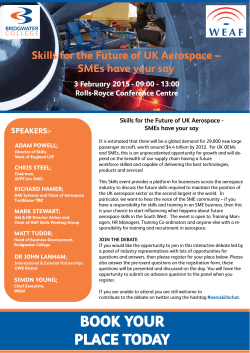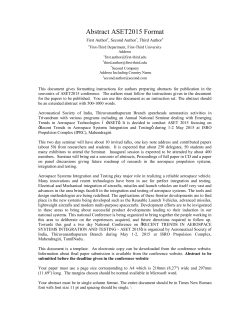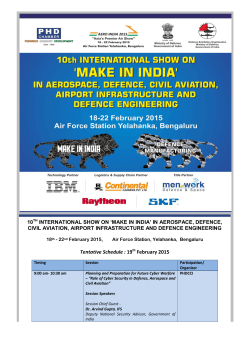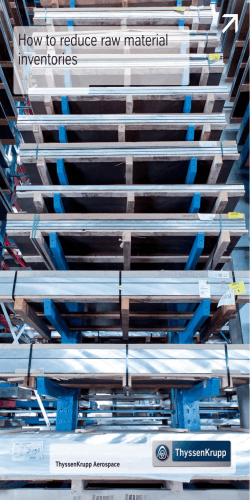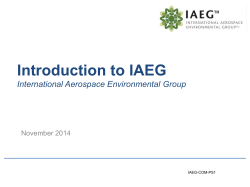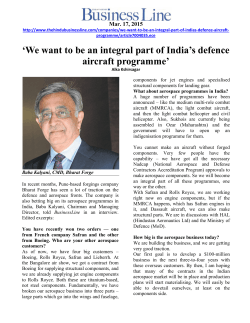
1. SAS Laboratory: Facilities The SASLab is equipped with the
1. SAS Laboratory: Facilities The SASLab is equipped with the following testing facilities. Website: www.saslab.eu 1. The SAS as Low Earth Orbits Simulator The SAS (Simulatore di Ambiente Spaziale) is a space environment simulator used for vacuum and thermal cycling tests typical of Low Earth Orbits (LEO). It is a large vacuum chamber 2.5 m length, hatch: 1.5 m diameter and volume around 5 m3. The Simulator is equipped with two RICOR Coolstar Cryo-pumps 3500 (pumping speed 34200 m³/h) in order to reach Pmin = 2E-4 Pa The vacuum chamber has 5 access points: 1 hatch, used to insert materials and structures inside the chamber 1 flange for the pre-vacuum pumping system linkage 2 portholes for the Cryo-pumps linkage 1 viewport, diameter 0.4 m, placed along the body of the simulator, next to a porthole The SAS control and programming is obtained by a dedicated software, which permits manual or fully automatic vacuum cycle programming. The pressure values reached inside the vacuum chamber are measured using pressure gauges located in several positions; the acquirement of these values is the start point for the step sequence used for vacuum cycle control. The SAS is equipped with a thermal-vacuum cavity, whose dimensions are 1.5m x 1m x 1m. Inside this sub-chamber, the UV effects are simulated using 3 UV lamps. The total power irradiated by UV lamps is 200 W/m2. The solar irradiance is simulated by 6 IR quartz tubes, whose total power irradiated is 1000 W/m2, near to total emission of the Sun. The maximum temperature reached is 120°C. In the following pictures, the SAS is shown. Page 1 of 15 2. The Thermal Cycling Shroud The SAS is equipped with a copper panel for LEO thermal-vacuum tests. The thermal cycling simulation Shroud, whose dimensions are 300 x 500 mm, is cooled by a liquid nitrogen system and heated by a series of resistors. The shroud operates in a temperature range between +150 and -150 °C. On the shroud there are 23 thermocouples, for chamber and sample temperature measurements. The thermal cycling system is controlled and programmed by a dedicated software which acquires temperature values measured by thermocouples and permits to set and report extreme temperature values, stasis, temperature gradient and cycling. The technical requisites followed for the shroud design and cycling features have been completely established referring to the International Standards ECSS-Q-70-04A. In the following pictures, the thermal cycling panel is shown. Page 2 of 15 Shroud Facility 3. The AOS Simulator The AOS (Atomic Oxygen Simulator), dedicated to perform Atomic Oxygen tests, is available at the Saslab. The high vacuum chamber is a stainless steel tube, 520 mm length and with internal diameter 160 mm, capable to reach a Pmin = 1E-5 Pa. The oxygen plasma is generated using a 13.56 MHz Radiofrequence OS-Prey Plasma Source, produced by SPECS. The estimate flux is 6.7E15 n.sp/cm2 s and the neutral plasma energy is ranging by (0.1 -20) eV varying the power supply setting. The vacuum chamber has 4 access points: 1 port left hand, where the RF Plasma Source is located 1 central port used for the Turbomolecular Pump linkage 1 right hand flange, on which a sample holder is placed A viewport, diameter 50 mm, placed in front of the Turbomolecular Pump, in the area in which the oxygen beam produced by the RF Source strikes the material sample. It is possible to test 1 sample for each test. The test duration is established calculating the Atomic Oxygen Fluence by ESA SPENVIS Simulation Code. After test mass loss measurements and Scanning Electron Microscopy analysis are performed, in order to evaluate the material properties changes. The test is performed following the Standard ASTM E 2089-00. The facility is located in a small clean room (class ISO 7). In the following pictures the RF Plasma Source and the AOS are shown. Page 3 of 15 AOS Facility 4. The OTF Facility The OTF (Outgassing Facility) facility is available at the SASLab. The facility has been designed completely according to the International Standard ESA ECSS-Q-7002A and ASTM E 595. The experimental apparatus is constituted by a pumping system composed by 1 Dry pump XDS5 (5 m³/h) and 1 Turbomolecular pump EXT255H (900 m³/h) in order to obtain a chamber pressure of 1E-3 Pa as the Standard requests. A dedicated copper sample holder is equipped by specimen cups in order to position 12 samples, in particular 3 different materials types and 3 reference values obtained through empty cavities. A system of chromium-coated aluminum collector plates is posed in front of each sample in order to collect the outgassed matter (CVCM). The Outgassing Simulator also works as a Vacuum Oven (Tmax = 150°C), since the used chiller device is capable to increase the collector plates temperature up 150 °C when the Cleaning of all the components is necessary. The system control and programming of the outgassing cycle will be automatic. After test, mass loss measurements and Spectrophotometric analysis are performed, in order to evaluate the outgassing effects on the tested materials. The facility is located in a small clean room (class ISO 7) In the following pictures, the Outgassing facility is shown. Page 4 of 15 OTF closed configuration OTF open configuration 5. The CVD Facility At the SASLab a Chemical Vapour Deposition (CVD) facility is available. The system has been achieved in order to obtain the Synthesis of nanostructures (carbon nanotubes grow) the study the and develop Nanostructured coatings (carbon, ceramics, metallic) on substrates of the advanced materials. It is constituted by a quartz tube in which vacuum conditions are obtained. The maximum operating temperature is 1600 °C and the argon, methane, hydrogen gas are used as ceramic precursors. In the following pictures, the CVD Facility is given. CVD Facility Page 5 of 15 6. The ACS Climatic Chamber An aging and conditioning system has been purchased by the SASLab Group. It is the ACS Angelantoni Challenge 250 climatic chamber. This climatic chamber is equipped with a humidification–dehumidification system and a cooling– heating system that can change the temperature and humidity in a controlled way by means of a touch screen and software control. This unit is capable of reaching a top temperature of 180 °C at a rate of 5 °C per minute and a low temperature of -75 °C, while the relative humidity can be regulated between a range from 0 to 90%. This facility is suitable for thermal cycling and conditioning in order to determine aging, knock down factors and behaviour of the samples submitted at different environmental conditions of humidity and temperature. In the following picture, the ACS Facility is shown. Challenge 250 climatic chamber Page 6 of 15 7. The High temperature Oven For more severe thermal conditions, a resistor electrical oven capable of reaching 650 °C at a maximum rate of 20 °C per minute is available. The internal dimensions are 91x64x60 cm. The oven is programmable through a digital control system. High temperature oven 8. Mechanical Testing Facilities The SASLab laboratory is equipped with two main mechanical and thermal testing machines. Material characterization is carried out through the use of these instruments. The first machine is the Schenck Trebel 100, whose functioning is based on a control box and an electrical 2200 kW motor generating constant displacement motion of the cross-head. The crosshead speed rate can vary from 1 to 900 mm/min while the maximun load carried is 100 kN. Several load cells can be adapted on the cross-head. Available load cells are: HBM Z4 100kN, U2A 10kN and U2B 5kN. The machine comes with 100 kN clamps for tensile test and uses tensile and compression 10 kN grips suitable also for thermo-mechanical testing. Fixtures for three point flexural or bending tests are also available and can be used in the ACS oven thanks to optional extensions. Test Fixtures for Shear Test by Compression Loading of Double-Notched specimens have been adapted to the Schenck Trebel testing machine. Page 7 of 15 In the following pictures, the Schenk Trebel machine is shown through some of its fixtures. A dedicated ACS Angelatoni TY 90 CN2 200 °C ventilated oven can be inserted in order to perform the thermo-mechanical tests. For more severe thermal testing conditions, a small resistors electrical oven capable of reaching 900 °C at a maximum rate of 40 °C per minute is available. Both tensile grips and bending fixtures can be used along with this oven. The mechanical Testing machine satisfy the following ESA Standards: ECSS – E 30 part 2A ECSS – E 30 part 8A Schenck Trebel Testing Machine 9. The Dilatometer For thermal property database of all class of materials, the SASLab performs tests on thermal expansion coefficient using a LINSEIS L75H PT1600 dual push rod horizontal dilatometer. The following physical properties can be measured: Linear thermal expansion (∆L) Sinter-temperature and sinter-steps Determination of glass temperature (Tg) Page 8 of 15 Phase changes Optimization of burning processes Determination of thermal expansion coefficient (CTE) Volume changes Rate controlled sintering (RCS) The dilatometer operates over a temperature range from room temperature to 1600 °C, at heating rates of 0.1 – 100°C/min. It has a built in automatic pressure control digital display while a dedicated PC software is used for data acquisition and monitoring. The system is vacuum tight, allowing measurements to be carried out under either air or in protective atmosphere as well as vacuum. It is equipped with an alumina sample holder and pushrod. The temperature measurement on the sample is performed by a type S thermocouple. It can measure samples up to 50 mm long and with a diameter of up to 12 mm, with a maximum shrinkage/expansion of 5 mm of an accuracy of 1.25 nm. The Dilatometer complies with the Standard Guide for Testing the Thermal Properties of Advanced Ceramics: ASTM C 1470 ÷ E 228. In the following pictures, two details of the Dilatometer and its Alumina sample holder are shown. LINSEIS L75H PT1600 Page 9 of 15 10. The MicroBalance All weight measurements of the Atomic Oxygen and Outgassing effects analysis are performed using the Mettler-Toledo XP26DR Balance, with the Capacity ranging from 5.1 g to 22 and related Readability from 0.002 mg (for Atomic Oxygen and Outgassing mass loss evaluation) to 0.01 mg. The measurement device is equipped with some different weighing sample-holders and a ioniser that immediately neutralises the electrostatically-charged object. This system is very useful for the weighing of several types of thin film commonly used for space applications. All the measurements are executed in the clean room (class ISO 7). In figure below, the weighing apparatus is shown. Mettler-Toledo XP26DR Balance 11. SEM imaging The scanning electron microscopy (SEM) analysis will used for • C/C and C foam microstructural characterization techniques. SEM is used to examine the microstructure and surface topography of carbon specimens. • Analysis of fracture surfaces and fractography. SEM examination must be conducted to determine the mechanism and type of fracture. The main advantage of this technique is the large depth of focus, which is useful for the examination of fractured surfaces. Page 10 of 15 2. SAS Research Group Aerospace and Astronautics Department (DIAA), SAPIENZA University of Rome Organization – SASLab Laboratory. The University of "La Sapienza" in Rome is active in the aeronautical field since the early ‘20s when the School of Aeronautical Engineering was founded and subsequently denominated School of Aerospace Engineering. The School focalizes its activities on high level aerospace researches developed by the Experimental Center of Guidonia (near Rome) where the scientific contribution of Researchers as Prof. Crocco, Ferri, Broglio and others attributed the school an International prestige. The School immediately became the Italian Center of excellence in the aeronautical field and later also in space engineering. Inside the School of Aerospace Engineering (Department of Aerospace and Astronautics Engineering-DIAA), the SASLab (Scientific Aerospace Solutions Laboratory) laboratory, guided by Mario Marchetti (Full Professor of Space Structures), is presently working on the followings researches: Numerical analysis of advanced structures Development of composite materials for aerospace systems Study and experiments of the space environment effects Characterization and implementation of technologies (RTM, filament winding) useful to the manufacturing of aeronautics and space components Deployable devices and Mechanisms Inflatable structures Nanotechnologies Prof. Marchetti is also the founder of the Master in "Composite and Nanotechnologies for the Aerospace". A Master dedicated to new advanced composite materials for aerospace applications. The SASLAB Group collaborates with Space Agencies (ASI, ESA) in Italian and European research programs and also with leading Italian space industries as Alcatel Alenia Space Italy. In the School of Aerospace Engineering other Professors, Researchers and Ph.Ds perform the following related aerospace scientific activities: Space flight mechanics Electronics Astrodynamics Page 11 of 15 Non destructive testing Finite Element designing Guide Navigation and Control Electric and conventional Propulsion Etc. The School of Aerospace Engineering of the University of Rome "La Sapienza" is a focal point of all Italian aerospace engineering research activities. University of Rome – SASLab Experience In the last thirty years, the Research Group of the Department of Aerospace and Astronautics Engineering has worked actively in the design and development of advanced materials, structures and solutions for aerospace applications. In the advanced material technology studies have been performed in both traditional alloys (steel, aluminium, etc.) and composites (polymeric and metallic matrix using fibres and particles reinforcements). The glass and carbon fibres are typically studied for aeronautical and space components. All research activities (materials and structures) are characterized by the followings scheme: Study of the basic theories Study of the theoretical models Definition of a numerical model useful to describe the theories developed FEM analysis necessary to evaluate the numerical models Manufacture of material samples Characterization and validation (morphological, mechanical, thermal, chemical, electromagnetic, corrosion) of the material (or structural element) Manufacture of prototypes and demonstrators Integration of the material/structure in an advanced aerospace system The above activities are developed in collaboration with the major national and international Universities and public and private Companies that work in the aerospace engineering segment. The principal research activities (technologies included) of the Group are summarised as follow: materials (traditional alloys, metal matrix composites, polymeric composites, long fibres and nanoparticles reinforcements) Page 12 of 15 light aerospace structures (anisogrid and isogrid lattice structures) inflatable structures frequency selective surfaces (traditional and nanostructured) tribology stochastic analysis resin transfer moulding filament winding rapid prototyping small satellites design and manufacturing curing processes nanotechnologies chemical studies relative to polymeric materials acoustic problems radar and antenna structural characterization manufacturing of prototypes and demonstrators tests (mechanical, thermal, corrosion and chemical behaviour, electromagnetic) The Research Group is also involved in developing activities for Master courses adding their experience and knowledge to the preparation of young aerospace engineers. It possible to summarize the main research activities of the SASLAB as follow: SASLAB (Scientific Aerospace Solutions Laboratory) is a Research Laboratory, established in 1990 and specialized in Aeronautical and Space Technology research and development. It is located at the Aerospace and Astronautical Department of the University of Rome “La Sapienza”. The SASLAB Team, directed by Mario Marchetti, full professor of Space Structures at the School of Aerospace Engineering in Rome, is composed by Researchers and Aerospace Engineers, with a great experience in advanced technology research. SASLAB Team also trains pre-graduate students in its laboratories in order to provide a qualified scientific and technical education. The SASLAB Team collaborates with several Italian aeronautical and aerospace Companies and National and International Scientific Agencies : Alenia Aeronautica, Thales-Alenia Space Italy, ASTRIUM, Agusta/Westland, ASI, CIRA, CSM Centro Sviluppo Materiali, SELEX SI, ENEA, ESA, INFN, Aerosekur, Trelleborg, Umbra Cuscinetti, SegreDifesa, INFN, AVIO. The use of the SASLab testing equipment by industry fosters an excellent exchange of know-how and a transfer of technology between the Institute and Companies in the sector. Page 13 of 15 The SASLab Team is a leading partner in the two main Italian Space Agency programs: FLECS and ASA. Composite Technology The SASLAB Team works in the composite materials sector and in the advanced structures. The main technologies (RTM, Filament Winding, Hand Lay - up) are studied through a specific theoretical study followed by an intense experimental activity. The technological problems associated to the manufacturing of composite structures are analyzed using Certified Software and Facilities. The composite approach is characterized by the following steps: • Study of the basic materials (polymers, curing agents, fibers) • Material compound definition • Development of the technological procedures • Numerical and FEM analysis of the designed aerospace elements • Experimental characterization of the basic materials, composite samples and structures. A specific activity is performed in the sector of the multilayer Hybrid Composite Materials. Others activities are characterised by the use of composite materials for critical aerospace structural elements. The SASLAB Team works in the development of Multigrid Lattice Structures, that may represent the future of aerospace structures (aircraft fuselages, launchers, lattice panel, etc.). The research in composite finds application not only in the structural sectors, but also in others sectors such as radars, thermal managements, solid propellant, etc. Nanotechnology In the last five years, the SASLAB Team is working actively in the Nanotechnologies sector. The nanotech activities developed are: • synthesis of carbon nanotubes • characterization of nanomaterials Page 14 of 15 • carbon nanotubes purification • development of polymeric composite reinforced with nanoparticles of graphite and carbon nanotubes with the relative mechanical test • electromagnetic test of nanostructured composite • manufacturing of nanostructured thin film • nanostructured solid propellants for aerospace rocket boosters • development of simple FEM analysis of the carbon nanotubes embedded in a polymeric matrix • study of the mechanical fracture of the nanostructured composite materials • nanostructured coating of C-C composites • studies of the technologies requested to the manufacturing of metal and ceramic nanostructured composite Quality Assurance The SASLAB activities are monitored and controlled by a Quality Office constituted by Certified Staff. Each activity (theoretical, experimental, etc.) is performed using a specific Operative Procedure, developed by the Quality Office, following the International Standards. Design and Numerical Analysis The SASLab Engineers have a large experience in design and structural- thermal analysis on high performance structures for aerospace, aeronautic, naval and mechanical applications. The main commercial Numerical Codes are in use: Femap-Nastran, Catia V5, LS-Dyna,. The Structural Codes are capable to analyse metallic and flexible structures in order to solve a large variety of structural and impact (ballistic and bird impacts) problems. All designs undergo numerical simulation other than experimental testing in order to have a complete and more reliable evaluation. Page 15 of 15
© Copyright 2026

